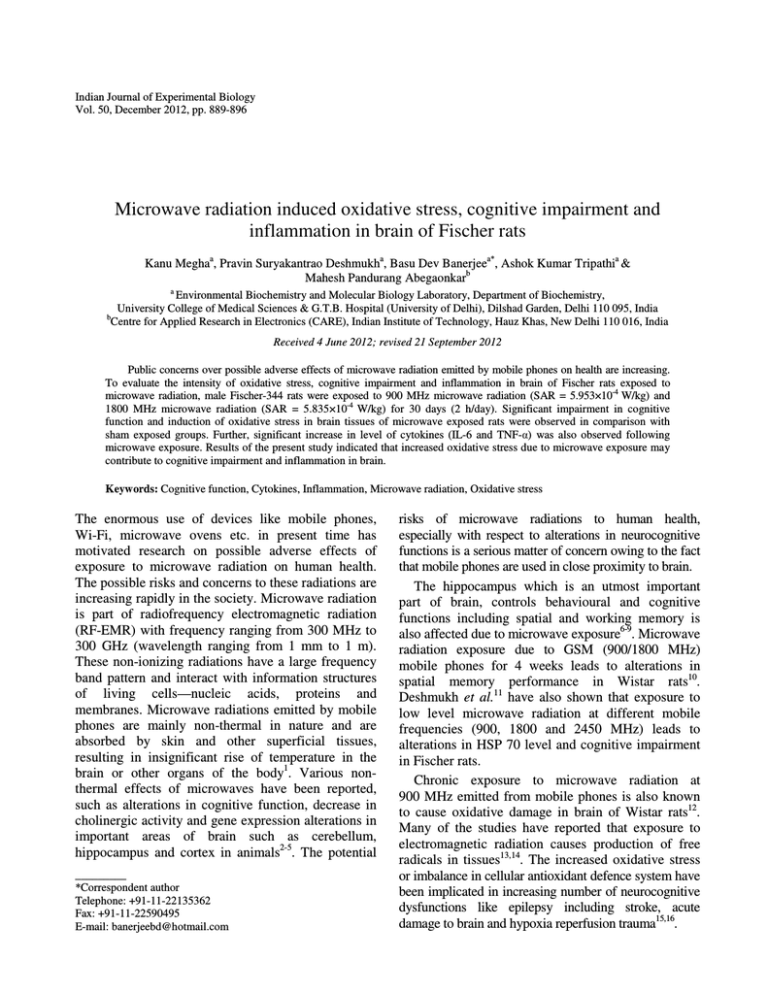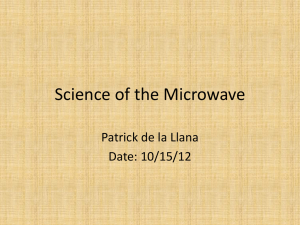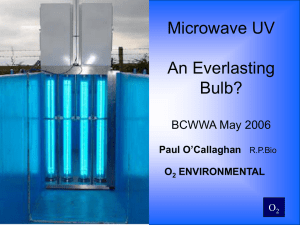
Indian Journal of Experimental Biology
Vol. 50, December 2012, pp. 889-896
Microwave radiation induced oxidative stress, cognitive impairment and
inflammation in brain of Fischer rats
Kanu Meghaa, Pravin Suryakantrao Deshmukha, Basu Dev Banerjeea*, Ashok Kumar Tripathia &
Mahesh Pandurang Abegaonkarb
a
Environmental Biochemistry and Molecular Biology Laboratory, Department of Biochemistry,
University College of Medical Sciences & G.T.B. Hospital (University of Delhi), Dilshad Garden, Delhi 110 095, India
b
Centre for Applied Research in Electronics (CARE), Indian Institute of Technology, Hauz Khas, New Delhi 110 016, India
Received 4 June 2012; revised 21 September 2012
Public concerns over possible adverse effects of microwave radiation emitted by mobile phones on health are increasing.
To evaluate the intensity of oxidative stress, cognitive impairment and inflammation in brain of Fischer rats exposed to
microwave radiation, male Fischer-344 rats were exposed to 900 MHz microwave radiation (SAR = 5.953×10-4 W/kg) and
1800 MHz microwave radiation (SAR = 5.835×10-4 W/kg) for 30 days (2 h/day). Significant impairment in cognitive
function and induction of oxidative stress in brain tissues of microwave exposed rats were observed in comparison with
sham exposed groups. Further, significant increase in level of cytokines (IL-6 and TNF-α) was also observed following
microwave exposure. Results of the present study indicated that increased oxidative stress due to microwave exposure may
contribute to cognitive impairment and inflammation in brain.
Keywords: Cognitive function, Cytokines, Inflammation, Microwave radiation, Oxidative stress
The enormous use of devices like mobile phones,
Wi-Fi, microwave ovens etc. in present time has
motivated research on possible adverse effects of
exposure to microwave radiation on human health.
The possible risks and concerns to these radiations are
increasing rapidly in the society. Microwave radiation
is part of radiofrequency electromagnetic radiation
(RF-EMR) with frequency ranging from 300 MHz to
300 GHz (wavelength ranging from 1 mm to 1 m).
These non-ionizing radiations have a large frequency
band pattern and interact with information structures
of living cells—nucleic acids, proteins and
membranes. Microwave radiations emitted by mobile
phones are mainly non-thermal in nature and are
absorbed by skin and other superficial tissues,
resulting in insignificant rise of temperature in the
brain or other organs of the body1. Various nonthermal effects of microwaves have been reported,
such as alterations in cognitive function, decrease in
cholinergic activity and gene expression alterations in
important areas of brain such as cerebellum,
hippocampus and cortex in animals2-5. The potential
_________
*Correspondent author
Telephone: +91-11-22135362
Fax: +91-11-22590495
E-mail: banerjeebd@hotmail.com
risks of microwave radiations to human health,
especially with respect to alterations in neurocognitive
functions is a serious matter of concern owing to the fact
that mobile phones are used in close proximity to brain.
The hippocampus which is an utmost important
part of brain, controls behavioural and cognitive
functions including spatial and working memory is
also affected due to microwave exposure6-9. Microwave
radiation exposure due to GSM (900/1800 MHz)
mobile phones for 4 weeks leads to alterations in
spatial memory performance in Wistar rats10.
Deshmukh et al.11 have also shown that exposure to
low level microwave radiation at different mobile
frequencies (900, 1800 and 2450 MHz) leads to
alterations in HSP 70 level and cognitive impairment
in Fischer rats.
Chronic exposure to microwave radiation at
900 MHz emitted from mobile phones is also known
to cause oxidative damage in brain of Wistar rats12.
Many of the studies have reported that exposure to
electromagnetic radiation causes production of free
radicals in tissues13,14. The increased oxidative stress
or imbalance in cellular antioxidant defence system have
been implicated in increasing number of neurocognitive
dysfunctions like epilepsy including stroke, acute
damage to brain and hypoxia reperfusion trauma15,16.
890
INDIAN J EXP BIOL, DECEMBER 2011
Although a number of studies on bioeffects of
microwave exposure on cognitive dysfunction are
reported, the neural mechanisms behind it are still not
clearly understood. In light of the above
considerations, the present study has been designed to
investigate the effects of microwave radiation
(at different mobile frequencies) on cognitive function
mediated via development of oxidative stress in rat
brain.
Materials and Methods
At the beginning of each experiment, all animals
used in this study were naïve, they had not been
undergone any kind of treatment.
Materials—Reduced
glutathione
(GSH),
2, 4-dinitrophenylhydrazine (DNPH), 5, 5′-Dithiobis
(2-nitrobenzoic acid) (DTNB) and 2-Thiobarbituric
acid (TBA) were procured from Sigma-Aldrich
company (St. Louis, Mo, USA) and rest of the
chemicals were obtained from Qualigens Fine
Chemicals, Mumbai, India and were of analytical
grade. IL-6 and TNF-α were estimated with
commercially available ELISA kits (Koma Biotech
Inc., Korea).
Animals—Male Fischer-344 rats (150-200 g body
weight) were obtained from central animal house
facility and kept under standard conditions of
temperature (22 ± 2 oC) and humidity (40-50%) under
alternating 12 h light and dark cycle. They were
provided with nutritionally adequate standard diet
obtained from Nutrilab, Bangalore, India and water ad
libitum. Animals were randomly selected and divided
into following 3 groups (6 animals in each group):
Group I sham exposed—animals not exposed to
microwave radiation but kept under same conditions
as that of other groups, group II—animals exposed to
900 MHz frequency at an average whole body
specific absorption rate (SAR) as 5.953×10-4 W/kg
and group III—animals exposed to 1800 MHz
frequency at an average whole body SAR as
5.835×10-4 W/kg. The microwave exposed groups
were exposed to 900 MHz and 1800 MHz microwave
radiation at power 0.00 dBm (1 mW) in a transverse
electromagnetic cell (TEM) cell for 2 h daily, 5 days per
week, every day at same time for 30 days. The power
density at plane of animal cages was 1.68 W/m2
(at 900 MHz) and 1.72 W/m2 (at 1800 MHz). The power
received by animals in the chamber was 0.2408 mW.
Appropriate permission was taken from Institutional
Animal Ethics Committee (IAEC) for animal
research, University College of Medical Sciences,
Delhi and appropriate care of the animals was
undertaken as per guidelines of Committee for the
Purpose of Control and Supervision of Experiments
on Animals (CPCSEA), India for laboratory animal
facilities.
Microwave exposure system, exposure conditions
and
dosimetry—The
gigahertz
transverse
electromagnetic (GTEM) cell GTE 10 has been
designed with the help of Center for Applied
Research in Electronics (Microwave laboratory),
Indian Institute of Technology, New Delhi and
Amitech Electronics Ltd., Sahibabad to estimate
biological effects of microwave radiation (Fig. 1). The
system provided by the manufacturer (Amitech
Electronics Ltd., Sahibabad, Ghaziabad, U.P) was
pre-calibrated
for
various
electromagnetic
characteristics and uniformity of E-field within the
TEM cell. The GTEM cell has been designed for
frequencies ranging from 9 KHz to 3.2 GHz, so the
same chamber works well for both 900 and 1800 MHz
as the present experimental requirements. GTEM cell
is a pyramidal tapered, dual terminated section with
its outer cell dimension as L: 220 cm × B: 120 cm ×
H: 80 cm. Microwaves are generated from Microwave
Generator SMC 100 (Rohde & Schwarz GmbH & Co,
Germany). The microwave source consists of a signal
generator operating at a frequency range from 9 KHz
to 3.2 GHz, an amplifier, a DC regulator and a power
meter. During the exposure rats were restrained in a
L: 30 cm × B: 20 cm × H: 15 cm closed box divided
into 4 compartments with holes of 1 cm diameter to
facilitate easy movement and breathing, kept at a
distance of 100 cm from source in quiet zone and
uniform field. At a time 6 rats were placed within the
device in two such boxes. The microwave chamber is
lined with absorbers which minimize the possibility of
any reflections. The uniformity of electric field was
experimentally checked by means of measurements
performed with an E-field probe (Rohde & Schwarz
NRV- Z32) inserted into the TEM cell through a
slit wall. The TEM cell was placed in a temperature
Fig. 1— Diagrammatic view of microwave exposure set up
KANU MEGHA et al.: MICROWAVE RADIATION, OXIDATIVE STRESS ETC. IN RATS
controlled room under constant lighting conditions.
Specific absorption rate (SAR) distribution was
calculated by Power Balance Method using the
following equation17:
Pabs per mouse = 1/n (Pin− Pout− Prefl)
where, Pabs = RF power in watt absorbed per animal,
n = number of animals within the cell, Pin= input
power (watt), Pout= output power (watt), and
Prefl= reflected power (Watt).
Microwave radiation exposure procedure—
Animals were given whole body exposure to
microwave radiation in transverse electromagnetic
(TEM) cell for 2 h/day, 5 days per week for 30 days.
Body weight of animals was recorded regularly on
weekly basis. Electromagnetic field parameters in
cages
were
measured continuously
during
experimental exposure. After the exposure period, all
animals were tested for spatial memory performance
using the Elevated plus maze (EPM) and Morris water
maze (MWM).
Experiment I: Effect of microwave exposure on
cognitive function
Elevated plus maze (EPM) paradigm testing—
Behavioural responses in rodents were measured by
elevated plus maze (EPM) test. It consists of two
opposite open arms (50×10 cm), crossed with two
closed arms of same dimensions with 40 cm high
wall. The arms are connected with central square
(10 × 10 cm). The animals were trained on EPM one
day prior to microwave exposure and acquisition was
measured in terms of seconds. Rats were placed
individually at one end of an open arm facing away
from the central square and allowed to enter either of
the closed arms and explore it for 20 sec. The time
taken by animal to enter one of the closed arms was
recorded as initial transfer latency (ITL). In elevated
plus maze the transfer latency (TL) of first day
(on 30th day of microwave exposure) indicates
acquisition of learning behaviour of animals whereas
TL of next day (on 31st day) indicates retention of
information or memory. The animal which could not
enter the closed arm within 90 sec was gently pushed
into one of the closed arms and the ITL was
mentioned as 90 sec. Retention of memory after 24 h
was evaluated in same manner18.
Morris Water Maze (MWM) testing—The
acquisition and retention of a spatial navigation task
was evaluated by Morris water maze. Animals
received a training session consisting of four trials in
891
a day, four days prior to exposure in Morris water
maze (180 cm diameter × 60 cm in depth) filled with
water. The pool was divided into four equal
quadrants. An escape platform was hidden 2 cm
below the surface of the water in a fixed location in
one of four quadrants halfway between the wall and
the middle of the pool. The position of the platform
was kept constant throughout the experimental trials.
The water was made opaque during the task with a
non toxic water soluble dye. Each trial consisted of
releasing a rat into the water facing the wall of the
pool, at one of four starting compass positions
(N, S, E, W) so that each position can be explored
well. The time to reach the escape platform (latency
in seconds) was recorded up to a maximum of 3 min.
The animal which could not find the platform up to
3 min was deliberately placed on the platform and
allowed to sit for 30 sec. The time taken by a rat to
reach the platform on fourth day was recorded and
mentioned as escape transfer latency (ETL).
Following 24 h after initial acquisition latency, a
probe test was done, where there was no platform and
each rat was randomly released from any one of the
positions and tested for the retention of the acquired
memory. During retention the time taken by each rat
to locate the target quadrant (quadrant in which
platform was placed during training) and time spent in
target quadrant for four 15 sec interval over 60 sec
was recorded10.
Experiment II: Effect of microwave exposure on
oxidative stress
Sample preparation and tissue homogenate—At
the termination of exposure, animals were sacrificed
immediately and brain tissues were collected and
washed thrice with phosphate buffer saline (PBS) and
hippocampus tissue was isolated and subsequently
homogenised (10% w/v) in PBS. Homogenate was
centrifuged and supernatant was collected for
estimation
of
oxidative
stress
parameters
(malondialdehyde, protein carbonyl and reduced
glutathione) and cytokines (IL-6 and TNF-α).
Determination of total brain protein—Total protein
content in brain was determined according to Lowry’s
method using bovine serum albumin as standard19.
Determination of malondialdehyde (MDA)— The
intensity of lipid peroxidation in the rat brain was
spectrophotometrically
measured
based
on
thiobarbituric (TBA) response products20. Absorption
was measured at 532 nm. MDA, lipid peroxidation
end product concentration was measured per g protein
892
INDIAN J EXP BIOL, DECEMBER 2011
using the molecular extinction coefficient of MDA
(1.56×10–5 mol-1 cm-1) and was expressed as µmol/g
protein.
Determination of protein oxidation—The level of
oxidative modification of proteins i.e. carbonyl group
concentration was determined spectrophotometrically
by standard protocol of Reznick and Packer21 using
2, 4 dinitrophenylhydrazine (DNPH), reagent often
used to test carbonyl groups. Reactive carbonyl
concentration was calculated using DNPH molar
extinction coefficient (22×103 mol-1 cm-1) at 390 nm
and expressed in µmol/g protein.
Determination of reduced glutathione (GSH)—The
reduced glutathione (GSH) content in rat brain was
measured per g protein by the standard protocol of
Ellman22 using 5, 5’ dithiobis-2 nitrobenzoic acid
(DTNB). In this method, GSH was oxidized by DTNB
and then reduced by GSH reductase with NADPH as
hydrogen donor. The oxidation of GSH by DTNB was
detected by measuring absorbance at 412 nm and GSH
content was expressed as µg/g protein.
Experiment III: Effect of microwave exposure on
inflammation
IL-6 and TNF-α estimation—IL-6 and TNF-α were
estimated with commercially available ELISA kits by
following instructions given by the manufacturer.
Statistical analysis—The present report was
designed as blind study for statistical analysis. Values
were expressed as mean±SD. Statistical analysis was
performed with SPSS (version 17.0). Significance of
differences among groups was determined by one way
analysis of variance (ANOVA) followed by Tukey’s
post-hoc test. Statistical significance was accepted at
P <0.05.
Results
Effect on cognitive function—Effects of microwave
exposure on cognitive performance at power level of
0.00 dBm (1mW) and frequencies 900 MHz and
1800 MHz at average whole body specific absorption
rate (SARs) as 5.953×10-4 W/kg and 5.835×10-4 W/kg
respectively for 30 days on cognitive performance
were estimated by using elevated plus maze (EPM)
and Morris water maze (MWM) tests (Experiment I).
During elevated plus maze test significant
alterations in transfer latency (TL) of 30th day as well
of 31st day were observed in microwave exposed
groups when compared with sham exposed groups
(Fig. 2). Animals exposed to microwave radiation at
above mentioned frequencies for 30 days showed
significant reduction (P< 0.05) in time taken to enter
the closed arm of EPM on 30th as well as 31st day of
microwave exposure in comparison with non-exposed
animals indicating learning and memory impairment.
Another test (MWM) was also performed to
estimate spatial memory performance in rats exposed
to microwave radiation. Exposure to microwave
radiation at 900 MHz and 1800 MHz for 30 days
produced significant alterations on escape transfer
latency (ETL) in comparison to sham exposed group
(P< 0.05). It was also observed that during the probe
trials (with platform removed) microwave exposed
rats took longer time to locate the place where
platform was kept (Fig. 3). The latency to reach the
target quadrant was significantly longer (P< 0.05) in
microwave exposed group and the time spent in the
target quadrant was significantly shorter (P< 0.05)
when compared to the sham exposed group.
Although, the effects of microwave radiation
exposure on cognitive function were significant in
microwave exposed groups (900 MHz and 1800 MHz)
in comparison with sham exposed group but the
results were found insignificant when comparison was
done between microwave exposed groups.
Effect on oxidative stress—In microwave exposed
groups (900 MHz and 1800 MHz), 30 days of
exposure lead to significant (P< 0.05) increase in the
level of MDA in brain, a marker of lipid peroxidation
as compared to sham exposed group (Experiment II)
(Fig. 4a).
Fig. 2—Transfer latency (TL) of rats during elevated plus maze
test (a) Acquisition and (b) retention. *P values < 0.05.
KANU MEGHA et al.: MICROWAVE RADIATION, OXIDATIVE STRESS ETC. IN RATS
Fig. 3—(a) Escape latency time (ELT) of rats during Morris water
maze test to locate hidden platform, (b) time spent in Q-4
(target quadrant). *P values < 0.05.
Fig. 4Effect of microwave radiation exposure on (a) lipid
peroxidation (µmol/g protein) (b) protein oxidation (µmol/g protein)
and (c) reduced glutathione (GSH) (µg/g) (*P values < 0.05).
compared to the sham exposed group, **compared between
900 MHz and 1800 MHz exposed groups
893
Microwave exposure (900 MHz and 1800 MHz)
also produced a significant (P< 0.05) increase in
carbonyl content, an index for oxidative modification
of proteins in brain tissue of exposed rats in
comparison with non-exposed groups (Fig. 4b). The
carbonyl content in brain was also found increased
significantly in 1800 MHz exposed groups in
comparison with 900 MHz group (P< 0.05).
In addition to this exposure to microwave radiation
at frequencies 900 and 1800 MHz for 30 days
produced a significant (P< 0.05) decrease in reduced
glutathione content in brain (Fig. 4c).
Except the level of protein carbonyl, the alterations
in levels of MDA and reduced glutathione were found
insignificant among microwave exposed groups
(900 MHz and 1800 MHz) when compared with each
other.
Effect on Inflammation—Microwave exposure at
mobile frequencies (900 and 1800 MHz) for
30 days produced a significant increase in level of
IL-6 (Experiment III) (Fig. 5a). Also a significant
(P< 0.05) increase was observed in level of
TNF-α content, a pro-inflammatory marker in
microwave exposed groups (Fig. 5b). The results of
bioeffects of microwave radiation on levels of these
Fig.5—Effect of microwave radiation exposure on (a) level of
pro- inflammatory cytokine IL-6 (pg/mL), (b) level of TNF-α
(pg/mL) in rat brain. *P values < 0.05.
894
INDIAN J EXP BIOL, DECEMBER 2011
pro-inflammatory cytokines were not found
significant in microwave exposed groups (900 and
1800 MHz) in comparison with each other.
Discussion
The present study is a part of our efforts to
recognize the bioeffects of microwave radiation
exposure due to excessive usage of devices like
mobile phones, Wi-Fi devices, microwave ovens etc.
on human health. Various studies on possible adverse
effects of exposure to microwave radiation on human
health provide contradictory results23,24.
This study provides three important findings
related to effects of microwave exposure at
frequencies 900 and 1800 MHz and power 0.00 dBm
for 30 days.
Firstly, it was shown that exposure to low level
(0.00 dBm) microwave radiation at above mentioned
frequencies for 30 days leads to significant alterations
in spatial learning and memory functions in rats
(Experiment I). Exposure to these radiations at SAR
levels (5.953×10-4 W/kg and 5.835×10-4 W/kg) even
far below the limit of 2 W/kg for possible exposure to
head as per International Commission on
Non-Ionizing Radiation Protection (ICNIRP)
guidelines caused neurocognitive dysfunction in
rats25. The SAR values in the present study were low but
and not too different from each other due to the reason
that frequencies chosen (900 MHz and 1800 MHz) were
also close to each other. Inspite of same input power,
the two SAR values differ due to the differences in
values of power levels (i.e. Pin, Pout, and Prefl) used in
equation to calculate the SAR are different at
900 MHz and 1800 MHz. The results of tests used to
estimate cognitive function indicate increased anxiety
level and impairment in learning and memory in
response to microwave radiation exposure (at 900 and
1800 MHz) for 30 days. The present results are in
support with the study of Narayanan et al.10 where
effects of microwave radiation emitted from GSM
(900/1800 MHz) mobile phones for 4 weeks have
been reported on cognitive function in Wistar rats. In
another study by Lai et al.26 it has been shown that
microwave exposure at 2.45 GHz alters the spatial
working memory assessed using radial arm maze.
Recently Deshmukh et al.11 have shown that low level
microwave radiation (power level 0 dBm,
frequencies 900, 1800 and 2450 MHz) leads to
cognitive impairment by alternative pathway
suggesting role of heat shock protein (HSP 70).
Although a number of studies have been reported
on effects of microwave exposure on cognitive
function but to the best of our knowledge none of the
studies have shown effects of these radiations on
cognitive function at different mobile frequencies
(lower range-900 MHz and higher range 1800
MHz). Moreover, the neural mechanism behind
cognitive impairment caused due to microwave
radiation is still unclear. Thus the present study was
carried out in order to bridge the gaps between
knowledge related to bioeffects of microwave
radiation on cognitive function and to understand the
possible causes behind microwave induced cognitive
impairment.
Secondly, it was observed that microwave radiation
at frequencies 900 and 1800 MHz, SAR levels
(5.953×10-4 W/kg and 5.835×10-4 W/kg respectively)
and power 0.00 dBm for 30 days caused oxidative
stress in rat brain biochemically by increasing levels
of MDA, a marker of lipid peroxidation (Fig. 4a)
(Experiment II). This observation suggests that
microwave radiation at above mentioned frequencies
can induce oxidative stress as indicated by increased
level of MDA in brain. Similar findings have been
reported by Sokolovic et al.12 where it has been shown
that exposure to 900 MHz microwave radiation at
SAR 0.043-0.135 W/kg can induce brain damage by
increasing lipid peroxidation. In another study
reported by Ilhan et al.27 it has been shown that
exposure to microwave radiation at 900 MHz leads to
increase in MDA level in rat brain tissue. In addition
to increased MDA level it was also observed in the
present study that microwave radiation exposure
under the present experimental conditions caused
significant increase in protein carbonyl content, an
index of oxidative modification of proteins (Fig. 4b).
Microwave radiations could be possible sources of
generation of free radicals which are known to cause
oxidative stress13,14. Proteins are known to be
susceptible to attack of free radicals due to amino acid
residues present in them. Thus it suggests that free
radicals produced as a result of microwave radiation
might have caused oxidation of proteins in brain. The
present results are in support with the findings of
Sokolovic et al.12 where it has been reported that
exposure to 900 MHz microwave radiation at SAR
0.043-0.135 W/kg causes protein oxidation in rat
brain. Besides these two oxidative stress parameters
the level of reduced glutathione (GSH), the most
important antioxidant in brain was also estimated
KANU MEGHA et al.: MICROWAVE RADIATION, OXIDATIVE STRESS ETC. IN RATS
(Fig. 4c). Exposure to microwave radiation at 900 and
1800 MHz for 30 days caused significant reduction in
level of GSH. GSH protects cells from reactive singlet
oxygen, hydrogen radical and superoxide radical
damage by reacting with them. Abnormalities in
glutathione scavenging system have been associated
with several psychiatric and neurological processes28.
Thus the present observation suggests that microwave
radiation exposure causes decrease in scavenging
ability of reduced glutathione. In a similar study by
Moussa et al.29 it has been reported that whole body
microwave radiation exposure to rats at 3.5 GHz leads
to reduction in reduced glutathione.
The free radicals generated due to microwave
radiation exposure stimulate T-helper cells that are
important during the beginning of an immune
response. Stimulated T-helper cells may secrete
pro-inflammatory cytokines like IL-6, TNF-α, IL-2
etc. Thus the induced oxidative stress may also lead to
inflammatory imbalances in whole brain or in isolated
regions that control specific functions related to
learning and memory.
Exposure to these radiation lead to inflammation in
brain tissues of exposed rats as evidenced by
significantly increased levels of pro-inflammatory
cytokines namely, IL-6 and TNF-α (Figs 5a and b)
(Experiment III). Thus it is suggested from the
observations that microwave radiation induced free
radicals might have lead to inflammation in brain of
exposed rats. Similar findings have been reported by
Wu et al.30 where increased levels of TNF-α, IL-1β and
IL-6 were observed in sertoli cells after exposure to
microwave radiation. In another study by Yang et al.31
it has been reported that exposure to electromagnetic
fields (EMFs) activate cultured microglial cells to
produce TNF-α through signal transduction.
In summary, the present results suggest that nervous
system due to being vulnerable to attack of free
radicals because of its low cellular turn over, poor
antioxidant defence system and high metabolic rate is
an easy target of microwave radiation emitted by
mobile phones. Oxidative stress caused due to
increased production of reactive oxygen species (ROS)
or deterioration of antioxidant system has been closely
linked to in vivo neuronal degeneration, as well as in
stroke, trauma, and seizures32. Thus the present
findings support the hypothesis that induced oxidative
stress in response to microwave radiation could be one
of the common causative factors in derangement of
cognitive function and inflammatory imbalances.
895
Interestingly, similar observations were noted in
animals exposed to both frequencies due to the reason
that frequencies (900 MHz and 1800 MHz) used in
the present study are quiet close to each other in terms
of their biological effects.
Conclusion
Based on the present findings it is concluded that
there is a probable role of microwave radiation
exposure induced production of free radicals in
development of inflammatory imbalances and
oxidative damage in brain as indicated by impairment
in spatial learning and memory. Further studies on
mechanisms leading to altered cognitive function
following microwave exposure with reference to
neurotransmitters are undergoing.
Acknowledgement
Authors are thankful to Indian Council of Medical
Research (ICMR), New Delhi for providing the
microwave exposure facility and supporting the study.
One of the authors, Kanu Megha is grateful to
Department of Science and Technology, Govt. of
India for providing DST/INSPIRE Fellowship
support.
References
1 Electromagnetic fields and public health: mobile phones.
Fact sheet No. 193, June 2011. http://www.who.int/media
centre/factsheets/fs193/en/.
2 Lai H, Carino M A, Horita A & Guy A W, Opiod receptor
subtypes that mediate a microwave induced decrease in
central cholinergic activity in rat, Bioelectromagnetics, 13
(1992) 237.
3 Keetly V, Wood A W, Spong J &Stough C,
Neurophysiological sequelae of digital mobile phone
exposure in humans, Neurophysiologica, 44 (2006) 1843.
4 Nittby H, Grafstrom G, Tian D, Brun A, Persson B R R,
Salford L G & Eberhardt J, Cognitive impairment in rats
after long term exposure to GSM- 900 mobile phones,
Bioelectromagnetics, 29 (2008) 219.
5 Nittby H, Widergren B, Krogh M, Grafstrom R G, Berlin H,
Eberhardt J L, Malmgren L, Persson B R R & Salford L G,
Exposure to human from global system for mobile
communication at 1800 MHz significantly changes gene
expression in rat hippocampus and cortex, Environmentalist,
28 (2008) 45.
6 Eichenbaum H, Otto T & Cohen N J, The hippocampus-what
does it do? Behav Neural Biol, 57 (1992) 2.
7 McEwen B S, The plasticity of the hippocampus is the
reason for its vulnerability, Semin Neurosci, 6 (1994) 239.
8 Xu S, Ning W, Xu Z, Zhou S, Chiang H & Luo J,
Chronic exposure to GSM 1800-MHz microwaves reduces
excitatory synaptic activity in cultured hippocampal neurons,
Neurosci Lett, 398 (2006) 253.
896
INDIAN J EXP BIOL, DECEMBER 2011
9 Odaci E, Bas O & Kaplan S, Effects of prenatal exposure to a
900 MHz electromagnetic field on the dentate gyrus of rats: a
stereological and histopathological study, Brain Res, 238
(2008) 224.
10 Narayanan N S, Kumar S R, Potu K B, Nayak S & Mailankot
M, Spatial memory performance of Wistar rats exposed to
mobile phone, Clinics, 64 (2009) 231.
11 Deshmukh P S, Kanu Megha, Banerjee B D, Abegaonkar
MP, Ahmed R S, Tripathi A K. Mediratta P K, Modulation
of HSP level and cognitive impairment in Fischer rats
exposed to low level microwave radiation, Asiatic J Biotech
Res, 3 (2012) 1391.
12 Sokolovic D, Djindjic B, Nikoloc J, Bjelakovic G, Pavlovic
D, Kocic G, Krstic D, Cvetkovic T & Pavlovic V, Melatonin
Reduces Oxidative Stress Induced by Chronic Exposure of
Microwave Radiation from Mobile Phones in Rat Brain,
J Radiat Res, 49 (2008) 579.
13 Zmyslony M, Rajkowska E, Mamrot P, Politanski P &
Jajte J, The effect of weak 50 Hz magnetic fields on the
number of free oxygen radicals in rat lymphocytes in vitro,
Bioelectromagnetics, 25 (2004) 607.
14 Simko M, Hartwig C, Lantow M, Lupke M, Mattsson M O,
Rahman Q & Rollwitz J, Hsp70 expression and free radical
release after exposure to non-thermal radio-frequency
electromagnetic fields and ultrafine particles in human Mono
Mac 6 cells, Toxicol Lett, 161 (2006) 73.
15 Siesjo B, Pathophysiology and treatment of focal cerebral
ischemia. Part II: Mechanisms of damage and treatment,
J Neurosurg, 77 (1992) 337.
16 Faden A I, Demediuk P, Panter S S & Vink R, The role of
excitatory amino acids and NMDA receptors in traumatic
brain injury, Science, 244 (1989) 798.
17 Ardoino L, Lopresto V, Mancini S, Marino C, Pinto R &
Lovisolo AG, A radio-frequency system for in vivo pilot
experiments aimed at the studies on biological effects of
electromagnetic fields, Phys Med Biol, 50 (2005) 3643.
18 Yadav C S, Kumar V, Suke S G, Ahmed R S, Mediratta P K &
Banerjee B D, Propoxur-induced acetylcholinesterase inhibition
and impairment of cognitive function: Attenuation by Withania
somnifera, Indian J Biochem Biophy, 47 (2010) 117.
19 Lowry O H, Rosebrought N J, Farr A L & Randall R J,
Protein measurement with the Folin phenol reagent, J Biol
Chem, 193 (1951) 265.
20 Ohkawa H, Ohishi N &Yagi K, Assay for lipid peroxides in
animal tissues by thiobarbituric acid reaction, Anal Biochem,
95 (1979) 351.
21 Reznick Z A & Packer L, Oxidative damage to proteins:
spectrophotometric method for carbonyl assay, Methods
Enzymol, 233 (1994) 357.
22 Ellman G L, Tissue sulphydryl groups, Arch Biochem
Biophysics, 82 (1959) 70.
23 Chagnaud J L, Moreau J M & Veyret B, No effect of shortterm exposure to GSM-modulated low-power microwaves on
benzo(a)pyrene-induced tumours in rat, Int J Radiat Biol, 75
(1999) 1251.
24 Kuribayashi M, 1 Jianqing Wang J, Fujiwara O, Doi Y,
Nabae K, Tamano S, Ogiso T, Asamoto M & Shirai T, Lack
of effects of 1439MHz electromagnetic near field exposure
on the blood brain barrier in immature and young rats,
Bioelectromagnetics, 26 (2005) 578.
25 ICNIRP Report, Guidelines for limiting exposure to timevarying electric, magnetic, and electromagnetic fields
(up to 300 GHz). Health Phys, 74 (1998) 494.
26 Lai H, Horita A & Guy A W, Microwave irradiation affects
radial-arm maze performance in the rat, Bioelectromagnetics,
15 (1994) 95.
27 Ilhan A, Gurel A, Armutcu F, Kamisli S, Iraz M, Akyol O
& Ozen S, Ginkgo biloba prevents mobile phone-induced
oxidative stress in rat brain, Clin Chim Acta, 340 (2004)
153.
28 Fonnum F & Lock E A, The contribution of excitotoxicity,
glutathione depletion and DNA repair in chemically induced
injury to neurons: exemplified with toxic effects on
cerebellar granule cells, J Neurochem, 88 (2004) 513.
29 Moussa S A, Oxidative stress in rats exposed to microwave
radiation, Rom J Biophys, 19 (2009) 149.
30 Wu H, Wang D, Shu Z, Zhou H, Zuo H, Wang S, Li Y,
Xu X, Li N & Peng R, Cytokines produced by microwaveradiated sertoli cells interfere with spermatogenesis in rat
testis, Andrologia, 44 (2012) 590.
31 Yang X, He G, Hao Y, Chen C, Li M, Wang Y, Zhang G &
Yu Z, The role of the JAK2-STAT3 pathway in
pro-inflammatory responses of EMF-stimulated N9
microglial cells, J Neuroinflammation, 7 (2010) 54.
32 Coyle J T & Puttfarcken P, Oxidative stress, glutamate, and
neurodegenerative disorders, Science, 262 (1993) 689.






